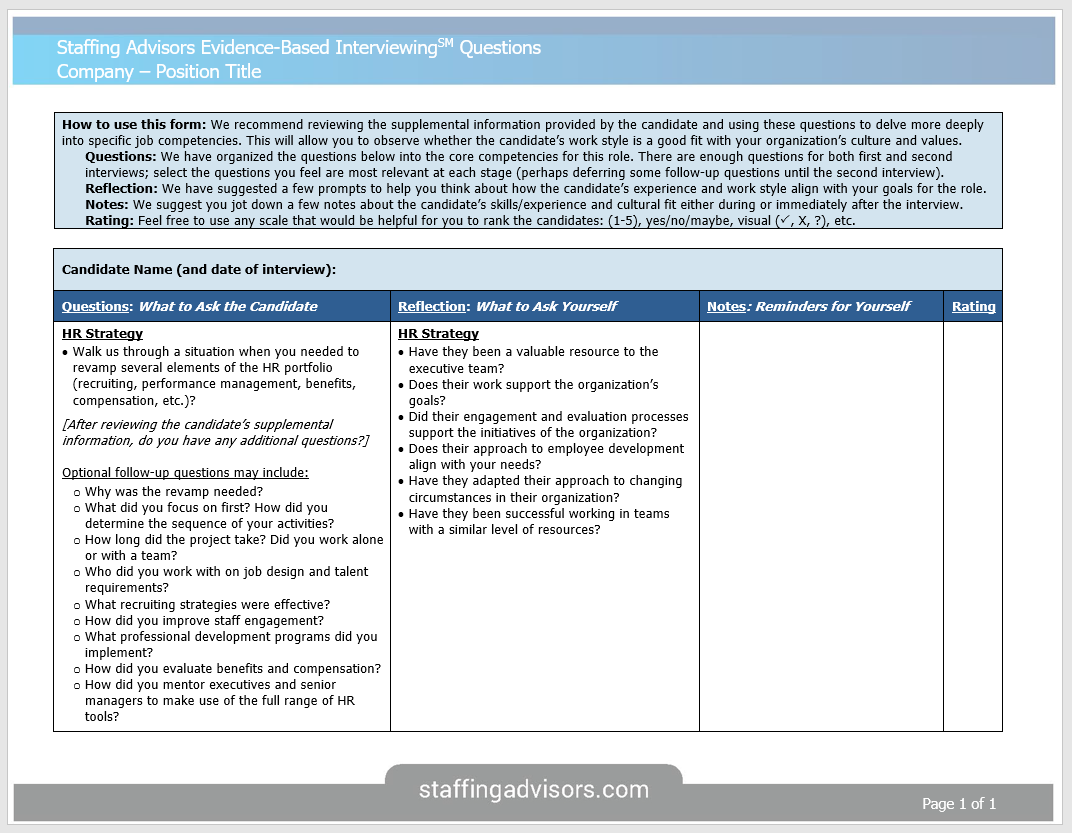For more than a decade, we’ve been looking closely at how we can help our clients assess cultural alignment—often referred to as cultural fit—without perpetuating bias. Across hundreds of completed searches, we’ve found that it’s entirely possible for employers to methodically assess cultural alignment during the interview process without perpetuating bias, but it usually requires a change in how you define, evaluate and discuss cultural alignment.
Arguments for and against assessing cultural alignment in hiring.
Some people have persuasively argued that hiring managers should steer clear of trying to assess cultural alignment in hiring because it leads to biased hiring decisions. Others have convincingly argued that employers do have a responsibility to assess cultural alignment in hiring and that it will not lead to discrimination if handled properly. The Society for Human Resource Management (SHRM) took the middle ground and had two HR experts debate the pros and cons of the topic in, “Does Hiring for ‘Culture Fit’ Perpetuate Bias? ”
From my review of the literature, it appears that the reason people are either for or against evaluating cultural alignment depends on their level of confidence that employers will invest the time and effort to be methodical in their assessments.
To reduce the impact of bias in your hiring practices, look very closely at how you assess cultural alignment in the interview. Untrained managers who are using an unstructured interview sequence will almost always perpetuate bias, regardless of their personal intentions. As legendary management guru W. Edwards Deming observed, “A bad system will beat a good person every time.”
How to define cultural alignment for your organization.
Organizational culture is remarkably hard to define and requires deep thinking from the start. In the absence of concrete guidelines, managers will almost always pivot to a focus on personal attributes because it is so much easier to think about and talk about. This focus on attributes kicks open the door to bias.
More than 10 years ago, we recommended these questions to help you begin to identify the elements of your culture. The list is far from comprehensive, but you will see that it is focused on how the work gets done, how decisions are made, and how much deference is given to others. These kinds of work-related factors are less prone to bias than asking a hiring manager to evaluate personality traits or whether someone possesses certain attributes like being innovative, dynamic, or a self-starter. Research has shown that people don’t have the objectivity to hold in their heads a stable definition of an abstract quality, and then accurately evaluate someone else on it.
Here are some of the stronger arguments I’ve seen for why employers need to define cultural alignment before trying to assess it:
“…few companies have gone through the rigor of making their ‘culture fit’ objective and measurable. Rather, HR professionals and hiring managers have simply adopted a new term for explaining hiring rationale that otherwise might be classified as invalid… if hiring managers define culture fit in terms of personality traits, favoring certain job candidates because they are ‘friendly’ or have ‘a good attitude,’ those managers hinder their organization’s ability to innovate because of its homogenous workforce. Conversely, hiring managers who describe their culture in qualitative terms, such as ‘low structure’ or ‘high autonomy with a complex matrix,’ have a better chance of mapping the skills and abilities of a diverse set of people into their culture …Similarly, if culture fit accounts for only 10 percent of a hiring decision, and the other 90 percent is based on skills and abilities, candidates who represent diversity have a better chance of being selected than if culture fit is 75 percent of the decision.” (Source)
“In a pattern researchers call looking-glass merit, hirers tend to look for traits in candidates that make them feel good about themselves. These may be more nuanced than race or gender. A manager who got bad grades as a college freshman is likely to warm to an applicant who also got off to a rough start, research shows. Or a hirer who attended a low-prestige school may favor applicants who did the same.” (Source)
“What most people really mean when they say someone is a good fit culturally is that he or she is someone they’d like to have a beer with. But people with all sorts of personalities can be great at the job you need done. This misguided hiring strategy can also contribute to a company’s lack of diversity, since very often the people we enjoy hanging out with have backgrounds much like our own.” (Source)
How to evaluate cultural alignment during the interview.
Some people recommend asking interview questions specifically related to cultural alignment (see examples here and here). In the past, I recommended this type of approach, but I no longer do. In general, I don’t find any predictive validity in asking candidates to rate themselves on any dimension. But now I’m far more concerned that hiring managers tend to interpret the answers through the lens of their own personal experience, not understanding the context the candidate is referring to. Again, this opens the door to more bias and less objectivity.
I’ve concluded that cultural alignment is not something you should directly ask candidates about, “So Jasmine, what is your ideal work culture? Do you think we have it here?” Instead, I recommend you ask questions about the candidate’s work experiences and skills, and then step back and reflect on whether that might be supplementary or complementary for your current team, either adding to or matching the skills, thinking, and working style of your current team. If they are making a contribution to the future of your culture, their diversity itself is a job qualification to be considered alongside every other competency, and, quite often, the right reason to select them.
Our practice is to provide our clients with customized interview questions for every search. Typically, there are five or six key competencies that really drive performance in any job. Each one should be evaluated separately. Here is an example for one job competency.
We recommend that our clients ask specific questions related to job competencies and then reflect on how that answer fits with the work culture of the organization. The interviewer is prompted with specific job-related and culture-related questions, and the form has a place to record their thoughts and ratings.
How to discuss cultural alignment.
What does it mean when a manager says they “liked” a candidate? When we debrief with the hiring manager after a successful interview, they often say, “I liked them.” We’re happy to hear that report and in the rush of a busy day, it’s easy to jump into scheduling the next step in the hiring process. But if you are committed to reducing systemic bias in your hiring process, and if you want to ensure you have hired the most highly qualified people, I recommend digging deeper and debriefing more carefully.
Avoid asking interviewers if they “liked” a candidate; it means different things to different people. Use language that’s more precise and fact-based. We know from experience that individual hiring managers use the “I liked them” phrase as a form of shorthand for many different concepts. When we ask, “What was it that stood out for you?”, managers respond by saying, “I’m excited by the fresh perspective that person brings to our team.” Or “I really like how they think and liked their approach to the work.” Or “I’m pleased with how their skills and competencies align with our needs.” On the surface, none of that is worrisome.
By far, the larger concern we have with the phrase “I liked them” is when it really means, “I liked them because they are socioeconomically and demographically similar to me. We share similar interests. I see myself reflected in them. They are someone I would get along with and I’d like to have a beer with them.” This is textbook bias.
When hiring managers begin their interviews with lengthy small-talk or icebreakers, there is a risk that the “liking” part happens before the “assessment” part of the interview, thereby throwing the accuracy of the assessment into question. Here’s another viewpoint on that:
“If you’re a hiring manager, you’re probably happiest getting a sense of a candidate through unstructured interviews, which allow you to randomly explore details you think are interesting and relevant. (What does the applicant think of her past employer? Does she like Chicago? What does she do in her downtime?) After all, isn’t your job to get to know the candidate? But while unstructured interviews consistently receive the highest ratings for perceived effectiveness from hiring managers, dozens of studies have found them to be among the worst predictors of actual on-the-job performance — far less reliable than general mental ability tests, aptitude tests, or personality tests.” (Source)
It’s not easy to eliminate systemic bias from your hiring practices. And as you adopt Competency-Driven Interviewing practices, your managers may initially be a bit uncomfortable. But that initial discomfort will be richly rewarded by the long-term benefits. You will hire people who are far more likely to succeed and help your organization succeed, you’ll make fewer hiring mistakes, and you’ll take pride in knowing your organization is taking effective, committed action toward fighting systemic bias. And your existing employees will applaud your leadership.
See Also:
- The Time Has Come for Competency-Based Interviewing
- How to Select Resumes Without Perpetuating Bias
- The Case for Competency-Driven Reference Checking
- What We Are Learning About Systemic Bias in Recruiting

